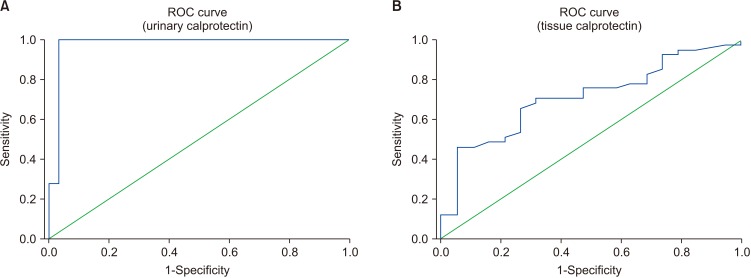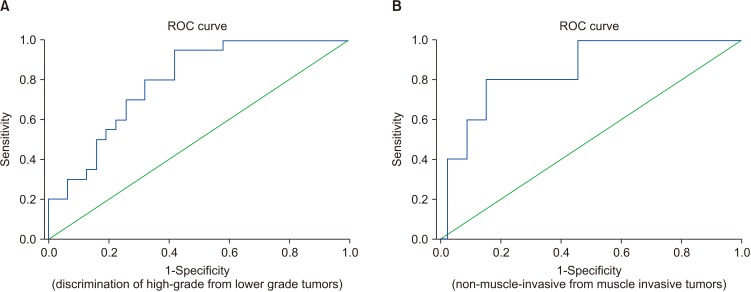Investig Clin Urol.
2019 Sep;60(5):343-350. 10.4111/icu.2019.60.5.343.
Improving the diagnosis of high grade and stage bladder cancer by detecting increased urinary calprotectin expression in tumor tissue and tumor-associated inflammatory response
- Affiliations
-
- 1Department of Urology, Bagcilar Training and Research Hospital, Istanbul, Turkey. dryusufsahin@hotmail.com
- 2Department of Urology, Istanbul Training and Research Hospital, Istanbul, Turkey.
- 3Department of Urology, Gebze Fatih State Hospital, Kocaeli, Turkey.
- 4Department of Biochemistry, Haseki Training and Research Hospital, Istanbul, Turkey.
- 5Department of Biochemistry, Istanbul Training and Research Hospital, Istanbul, Turkey.
- KMID: 2455961
- DOI: http://doi.org/10.4111/icu.2019.60.5.343
Abstract
- PURPOSE
To investigate whether measurement of urinary calprotectin can serve as a biomarker in the diagnosis of primary bladder cancer and to confirm its diagnostic role in determining high grade and stage disease.
MATERIALS AND METHODS
Urinary calprotectin was measured in spot urine samples from patients with primary bladder cancer and control subjects. To confirm levels in urine, tissue samples were also obtained from bladder tumor and healthy trigone of bladder by transurethral resection in both groups. Finally, calprotectin levels in tissue and urine of the patients and control subjects were compared and their diagnostic potential was investigated in high grade and stage bladder cancers.
RESULTS
Of 82 participants, 52 were patients with bladder cancer and 30 were control subjects. The two groups were comparable in terms of age, smoking status, and comorbidities. Tissue and urinary calprotectin levels were significantly higher in the bladder cancer group. In subgroup analyses, urinary calprotectin levels were significantly higher in patients with high-grade, muscle-invasive tumors. After receiver operating characteristic analyses, the sensitivity and specificity of urinary calprotectin was 100% and 96.7%, respectively, in the diagnosis of primary bladder cancer. High grade and stage bladder cancers were detected with sensitivity and specificity of 70% and 74.2%, and 80% and 84.8%, respectively.
CONCLUSIONS
Urinary calprotectin may be a valuable parameter in the diagnosis of primary bladder cancer with high sensitivity and specificity. Furthermore, it may be useful in the prediction of high grade and stage disease. However, more investigations are needed.
Keyword
MeSH Terms
Figure
Reference
-
1. Ferlay J, Soerjomataram I, Dikshit R, Eser S, Mathers C, Rebelo M, et al. Cancer incidence and mortality worldwide: sources, methods and major patterns in GLOBOCAN 2012. Int J Cancer. 2015; 136:E359–E386. PMID: 25220842.
Article2. Compérat E, Larré S, Roupret M, Neuzillet Y, Pignot G, Quintens H, et al. Clinicopathological characteristics of urothelial bladder cancer in patients less than 40 years old. Virchows Arch. 2015; 466:589–594. PMID: 25697540.3. Burger M, Catto JW, Dalbagni G, Grossman HB, Herr H, Karakiewicz P, et al. Epidemiology and risk factors of urothelial bladder cancer. Eur Urol. 2013; 63:234–241. PMID: 22877502.
Article4. Wakai K, Utsumi T, Oka R, Endo T, Yano M, Kamijima S, et al. Clinical predictors for high-grade bladder cancer before first-time transurethral resection of the bladder tumor: a retrospective cohort study. Jpn J Clin Oncol. 2016; 46:964–967. PMID: 27511986.
Article5. Yafi FA, Brimo F, Auger M, Aprikian A, Tanguay S, Kassouf W. Is the performance of urinary cytology as high as reported historically? A contemporary analysis in the detection and surveillance of bladder cancer. Urol Oncol. 2014; 32:27.e1–27.e6.
Article6. Schmitz-Dräger BJ, Droller M, Lokeshwar VB, Lotan Y, Hudson MA, van Rhijn BW, et al. Molecular markers for bladder cancer screening, early diagnosis, and surveillance: the WHO/ICUD consensus. Urol Int. 2015; 94:1–24. PMID: 25501325.
Article7. Nagata M, Muto S, Horie S. Molecular Biomarkers in bladder cancer: novel potential indicators of prognosis and treatment outcomes. Dis Markers. 2016; 2016:8205836. PMID: 26924873.
Article8. Nandagopal L, Sonpavde G. Circulating biomarkers in bladder cancer. Bladder Cancer. 2016; 2:369–379. PMID: 28035318.
Article9. Ebbing J, Mathia S, Seibert FS, Pagonas N, Bauer F, Erber B, et al. Urinary calprotectin: a new diagnostic marker in urothelial carcinoma of the bladder. World J Urol. 2014; 32:1485–1492. PMID: 24378824.
Article10. Yasar O, Akcay T, Obek C, Turegun FA. Significance of S100A8, S100A9 and calprotectin levels in bladder cancer. Scand J Clin Lab Invest. 2017; 77:437–441. PMID: 28609200.
Article11. Paner GP, Stadler WM, Hansel DE, Montironi R, Lin DW, Amin MB. Updates in the eighth edition of the tumor-node-metastasis staging classification for urologic cancers. Eur Urol. 2018; 73:560–569. PMID: 29325693.
Article12. Montironi R, Lopez-Beltran A. The 2004 WHO classification of bladder tumors: a summary and commentary. Int J Surg Pathol. 2005; 13:143–153. PMID: 15864376.
Article13. Stríz I, Trebichavský I. Calprotectin - a pleiotropic molecule in acute and chronic inflammation. Physiol Res. 2004; 53:245–253. PMID: 15209531.14. Rugtveit J, Brandtzaeg P, Halstensen TS, Fausa O, Scott H. Increased macrophage subset in inflammatory bowel disease: apparent recruitment from peripheral blood monocytes. Gut. 1994; 35:669–674. PMID: 8200563.
Article15. Røseth AG, Kristinsson J, Fagerhol MK, Schjønsby H, Aadland E, Nygaard K, et al. Faecal calprotectin: a novel test for the diagnosis of colorectal cancer? Scand J Gastroenterol. 1993; 28:1073–1076. PMID: 8303210.
Article16. Tibble JA, Sigthorsson G, Foster R, Scott D, Fagerhol MK, Roseth A, et al. High prevalence of NSAID enteropathy as shown by a simple faecal test. Gut. 1999; 45:362–366. PMID: 10446103.
Article17. Kim SK, Kim EJ, Leem SH, Ha YS, Kim YJ, Kim WJ. Identification of S100A8-correlated genes for prediction of disease progression in non-muscle invasive bladder cancer. BMC Cancer. 2010; 10:21. PMID: 20096140.
Article18. Minami S, Sato Y, Matsumoto T, Kageyama T, Kawashima Y, Yoshio K, et al. Proteomic study of sera from patients with bladder cancer: usefulness of S100A8 and S100A9 proteins. Cancer Genomics Proteomics. 2010; 7:181–189. PMID: 20656984.19. Luley K, Noack F, Lehnert H, Homann N. Local calprotectin production in colorectal cancer and polyps--active neutrophil recruitment in carcinogenesis. Int J Colorectal Dis. 2011; 26:603–607. PMID: 21380506.
Article20. Gisbert JP, McNicholl AG. Questions and answers on the role of faecal calprotectin as a biological marker in inflammatory bowel disease. Dig Liver Dis. 2009; 41:56–66. PMID: 18602356.
Article21. Tibble JA, Sigthorsson G, Foster R, Forgacs I, Bjarnason I. Use of surrogate markers of inflammation and Rome criteria to distinguish organic from nonorganic intestinal disease. Gastroenterology. 2002; 123:450–460. PMID: 12145798.
Article22. Poullis A, Foster R, Shetty A, Fagerhol MK, Mendall MA. Bowel inflammation as measured by fecal calprotectin: a link between lifestyle factors and colorectal cancer risk. Cancer Epidemiol Biomarkers Prev. 2004; 13:279–284. PMID: 14973103.23. Ortega FJ, Sabater M, Moreno-Navarrete JM, Pueyo N, Botas P, Delgado E, et al. Serum and urinary concentrations of calprotectin as markers of insulin resistance and type 2 diabetes. Eur J Endocrinol. 2012; 167:569–578. PMID: 22822112.
Article
- Full Text Links
- Actions
-
Cited
- CITED
-
- Close
- Share
- Similar articles
-
- The Value of Urine Cytology on Bladder Tumor
- The Diagnostic Value of Urine Cytology in Bladder Cancer
- The Prognostic Parameters for Recurrence in the Superficial Bladder Cancer
- The Significance of Urinary Nuclear Matrix Protein ( NMP ) as a Marker for Transitional Cell Carcinoma of the Bladder
- Pathologic Features of Recurrent Bladder Tumors after Upper Urinary Tract Transitional Cell Carcinoma



